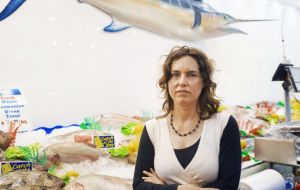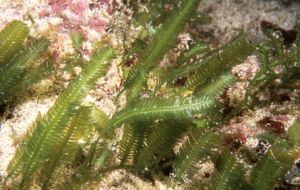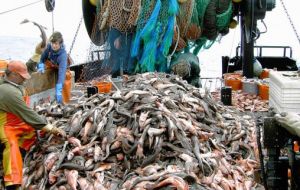MercoPress. South Atlantic News Agency
Australia debates effects of warming ocean waters on its fisheries
 “My research is showing that some of these things look like they have already increased in abundance because of climate change” says Prof Shauna Murray (Pic C. Pearce)
“My research is showing that some of these things look like they have already increased in abundance because of climate change” says Prof Shauna Murray (Pic C. Pearce)  Species of algal genus responsible for (tropical) ciguatera poisoning in Australia were found in bloom proportions in SE Australia for the first time.
Species of algal genus responsible for (tropical) ciguatera poisoning in Australia were found in bloom proportions in SE Australia for the first time.  FAO says per capita fish consumption globally has almost doubled since the 1960s, from an average of 9.9 to 19.2 kilograms.
FAO says per capita fish consumption globally has almost doubled since the 1960s, from an average of 9.9 to 19.2 kilograms. New evidence is emerging that climate change could join overfishing as a major threat to the world's seafood supplies. While Australia – a small producer on a global scale, accounting for only 0.2% of the world's seafood – has relatively healthy fisheries, it is suddenly and quite brutally feeling the effects of warming ocean waters.
Scientists concluded last year that species of the algal genus responsible for ciguatera poisoning in 13 people on the north coast of NSW in 2014 had been found in bloom proportions in south-eastern Australia for the first time. The disease is one normally associated with the tropics.
Its victims, who simply considered themselves unlucky, had eaten Spanish mackerel weighing more than 15 kilograms. Within hours, they had developed a burning skin sensation, severe diarrhea, vomiting, aches and cramps.
Associate Professor Shauna Murray, who works in the Plant Functional Biology and Climate Change Cluster at the University of Technology Sydney (UTS), says climate change may be allowing some of these marine microalgae – which produce the toxins that then accumulate in larger fish – to proliferate in waters previously considered too cold to support them.
“My research is showing that some of these things look like they have already increased in abundance because of climate change,” she says.
“[These are] the first cases that have been reported of fish caught in NSW waters and we've seen that just over the past two years,” she points out.
Murray, who works on detection methods, is researching how microalgae respond to living in different temperatures. She says other studies show a 60% rise in the incidence of ciguatera across the Pacific between the 1970s and the turn of this century.
Queensland reported 55 cases of ciguatera poisoning last year, compared with an average of 15 annually in the five preceding years. The impact on the fishing and aquaculture industries can be devastating.
One large-scale bloom of Alexandrium tamarense – which can cause paralytic poisoning in consumers of shellfish, such as mussels, clams, oysters and scallops – occurred on Tasmania’s east coast in late 2012. It left the fishing and aquaculture industry about 23 million Australian dollars worse off.
However, some fishers are not yet ready to ring the alarm and admit being skeptical about climate change. For his part, marine ecologist Professor David Booth says Australia overestimates the sustainability of its fisheries.
He says an unreported fishing account for one third of the world’s fishing. According to the United Nations Food and Agriculture Organization (FAO), per capita fish consumption globally has almost doubled since the 1960s, from an average of 9.9 to 19.2 kilograms. But the proportion of stocks fished within biologically sustainable levels has declined from 90% in 1974 to 71.2% in 2011.
The FAO estimates illegal, unreported and unregulated fishing takes between 11 million and 26 million tons of fish worldwide each year.
In Australia, seafood consumption is on the rise. We ate 345,326 tons of it in 2012-13, according to figures from the Australian Bureau of Agricultural and Resource Economics and Sciences. But the domestic supply is not keeping pace with the increased demand, forcing Australians to rely increasingly on imports, particularly of tuna, and frozen fish and prawns. According to ABARES, imports accounted for 66% of Australia’s total seafood intake in 2012-13. (FIS).




Top Comments
Disclaimer & comment rules-

-

-

Read all commentsYet another scientist jumping on the =global warming bandwagon with no supporting evidence, just speculation concerning a natural event.
Jul 22nd, 2015 - 08:28 am 0I'm prepared to accept human activity is affecting the climate...but wait!
Jul 22nd, 2015 - 10:58 am 0Once every Chinese and Indian has a car and a refrigerator, I think we'll all see it on the grand scale as they number almost half of humanity, we already consume one and a half times what the Earth can provide.
The planet will recover when we're gone
we already consume one and a half times what the Earth can provide.
Jul 22nd, 2015 - 12:14 pm 0Is that a bad translation?
WTF does it mean?
Commenting for this story is now closed.
If you have a Facebook account, become a fan and comment on our Facebook Page!